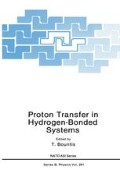Abstract
The idea to organize a meeting on transfers of protons through H-bonds is due to S.Pnevmatikos whose tragic death most unfortunately hindered us having his personal views on such a topics. It reveals a strong capacity of anticipation and of thinking in the long term from him. This topics “transfers of protons through H-bonds” corresponds to a concept which is not new but which more and more appears as a general crucial step in many reactions occuring in aqueous media and particularly in biological ones. As may be seen when looking at the different chapters of this book its importance slowly emerges and such a mechanism is now strongly suspected to be vital in many reactions at room temperature. We may think that within a short time it will be invoked by a wide variety of scientists in such various fields as physics, chemistry and biology.
Access this chapter
Tax calculation will be finalised at checkout
Purchases are for personal use only
Preview
Unable to display preview. Download preview PDF.
References
Y. Maréchal, La Recherche 20:480 (1989).
F. H. Stillinger, Science 209:451 (1980).
S. H. Chen and J. Teixeira, in:“Adv. Chem. Phys.”, Vol. LXIV, I. Prigogine and S. Rice,eds., J. Wiley (1986).
Y. Marechal, J. Chem. Phys. 95:5565 (1991).
F. Fillaux, A. Lautie, J. Tomkinson and G. J. Kearly, Chem. Phys. 162:19 (1989).
A. Novak, in:“Solid State Protonic Conductors III”,J. B. Goodenough, J. Jensen and A. Potier, eds., Odense University press (1985).
M. Falk, in:“Structure and Properties of Ionomers”, M. Pineri and A. Eisenberg, eds.,NATO ASI Series C, Vol. 198, D.Reidel, Dordrecht(1986).
D. C. Borgis, S. Lee and J. T. Hynes, Chem. Phys. Letters 76:88 (1989).
S. Pnevmatikos, Phys. Rev. Letters 60:1534 (1988).
S. Hayashi and J. Umemura, J. Chem. Phys. 60:2675 (1975).
S. Hayashi, M. Obotake, R. Nakamura and K. Mashida, J. Chem. Phys. 94:4446 (1991).
S. Nagaoka, T. Terao, F. Imashiro, A. Saika, N. Hirota and S. Hayashi, J. Chem. Phys. 79:4694 (1983).
R. M. Hochstrasser and H. P. Trommsdorff, Chem. Phys. 115:1 (1987).
A. Oppenlander, C. Rambaud, H. P. Trommsdorff and J. C. Vial, Phys. Rev. Letters 63:1432 (1989).
J. L. Skinner and H. P. Trommsdorff, J. Chem. Phys. 89:897 (1988).
R. Meyer and R. R. Ernst, J. Chem. Phys. 93:5518 (1990).
R. Nakamura and S. Hayashi, J. Mol. Struct. 145:331 (1986).
J. Lipinski and W. A. Sokalski, Chem. Phys. Letters 76:88 (1980).
N. Shida, P.F. Barbara and J. Almlof, J. Chem. Phys. 94:3633 (1991).
O. Bastiansen and T. Motzfeldt, Acta Chem. Scand. 23:2848 (1969).
A. Stockli, B. H. Meier, R. Kreis, R. Meyer and R. R. Ernst, J. Chem. Phys., 93:1502 (1990).
R. Nakamura, K. Mashida and S. Hayashi, J. Mol. Struct. 146:101 (1986).
H. R. Zelsmann and Z. Mielke, Chem. Phys. Letters 186:501 (1991).
Y. Mardchal, J. Chem. Phys. 87:6344 (1987).
Y. Marechal, J. Mol. Struct. 189:55 (1988).
J. March, “Advanced Organic Chemistry-Reactions,Mechanism and Structure”, Mc Graw Hill (1977).
D. Hadzi, J. Mol. Struct. 177:1 (1988).
C. Walsh, “Enzymatic Reaction Mechanism”, Freeman (1979).
Y. Maréchal, J. Mol. Liquids 48,253 (1991).
Author information
Authors and Affiliations
Editor information
Editors and Affiliations
Rights and permissions
Copyright information
© 1992 Springer Science+Business Media New York
About this chapter
Cite this chapter
Maréchal, Y. (1992). Transfers of Protons as a Third Fundamental Property of H-Bonds -Importance of Cooperative Resonance Type in Cyclic Structures. In: Bountis, T. (eds) Proton Transfer in Hydrogen-Bonded Systems. NATO ASI Series, vol 291. Springer, Boston, MA. https://doi.org/10.1007/978-1-4615-3444-0_1
Download citation
DOI: https://doi.org/10.1007/978-1-4615-3444-0_1
Publisher Name: Springer, Boston, MA
Print ISBN: 978-1-4613-6524-2
Online ISBN: 978-1-4615-3444-0
eBook Packages: Springer Book Archive

